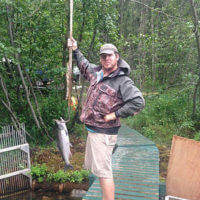The amount and quality of in-stream rearing habitat can influence the survival and growth of juvenile Pacific salmon. While seasonal habitat use of juvenile Coho salmon (Oncorhynchus kisutch) in freshwater environments has been examined in open-water environments during summer or in salmon systems at lower latitudes, understanding of overwinter habitat use in ice-bearing systems remains nascent. Juvenile Coho Salmon (JCS) remain in their natal streams for 1 – 4 years before smolting and demonstrate seasonal changes in habitat occupancy. Generally, fish occupy higher-flow main stem habitats in the summer and move to lower-flow off channel habitats in the winter. To date, there has been a lack of work focused on the habitat use and overwinter seasonal dispersal strategies of this species in regions with prolonged periods of freezing temperatures and persistent ice cover. In this study, passive integrated transponder (PIT) tags were used to track the seasonal movement of 3,305 JCS in two sub-drainages (Meadow Creek and Fish Creek) within the Big Lake watershed, located in Southcentral Alaska. The fish were tagged in 26 main-stem locations (13 Meadow Creek, 13 Fish Creek), 13 tributary locations (9 Meadow Creek, 4 Fish Creek), and nine lake locations (8 Meadow Creek, 1 Fish Creek) during the summers of 2011 and 2012, and were detected occupying seven off-channel overwintering areas for the duration of ice cover; the majority of which were lakes. The importance of distance from the estuary, dispersal direction, and fish length on overwintering area choice was examined using a classification tree framework owing to its flexibility in assessing the
relationship between predictor variables and dispersal pathways in predicting overwinter area choices of tagged fish. Final fitted models were successful at describing overwinter location selection, producing low misclassification rates ranging from 9 – 13%. Dispersal direction was the most important predictor of overwintering area choice for fish tagged in the Meadow Creek sub-drainage for both years, and distance from the estuary was the most important for the Fish Creek sub-drainage. The consistency of model results across years and drainages demonstrated that overwinter redistribution behavior of JCS was regular and predictable, emphasizing lakes as strongly preferred overwinter habitat as well as indicating that fish generally found their way model results across years and drainages demonstrated that overwinter redistribution behavior of JCS was regular and predictable, emphasizing lakes as strongly preferred overwinter habitat as well as indicating that fish generally found their way to the nearest overwinter habitat proximal to their summer rearing locations. The observed seasonal migration patterns from summer rearing locations to off-channel overwintering areas such as lakes is consistent with previous published findings; however, this is the first known study to track the individual-level movements of JCS using PIT tag technology in a high latitude, seasonally ice-covered watershed.
Current Status: Fish Biologist, Fish and Wildlife Service Anchorage Conservation Office (Anchorage, Alaska)
Funding for this work was provided by the Pollock Conservation Cooperative via the Alaska Education Tax Credit Program.

